Object Gallery
Stand Supported by the Figure of a Frog
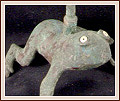 [/kish/fieldmus/images/OB28-large.jpg]
[/kish/fieldmus/images/OB28-large.jpg]
Iraq is a land of rivers, canals, and marshes—all teeming with wildlife. Frogs like the one that forms the base of this stand, which might have supported a goblet, are a common sight, and must have been so in ancient times.
Kish East, Ingharra, Y Sounding, 6 m. below plain level. Copper alloy and stone. Early Dynastic Period. Field Museum 236392
Ostrich Egg-shell Cup
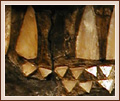 [/kish/fieldmus/images/OB13-large.jpg]
[/kish/fieldmus/images/OB13-large.jpg]
At least through the end of the first millennium B.C., ostriches ranged wild throughout what is now southern Iraq. They were hunted for sport, and their eggs were transformed into elaborate drinking cups, like the one shown here.
Kish East, Mound A, Burial A88. Ostrich egg shell, bitumen, mother-of-pearl. Early Dynastic Period. Field Museum 156986
Horse and Rider
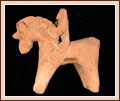 [/kish/fieldmus/images/OB3-large.jpg]
[/kish/fieldmus/images/OB3-large.jpg]
It is not known for certain when the horse was domesticated, but by the first millennium B.C. it appears to have been in extensive use. Figurines showing a horse and rider were extremely common during the Parthian Period.
Kish West, Mound W, depth 1m. Baked clay. Parthian Period. Field Museum 229937
Stucco Panel Showing a Ram's Head above a Pair of Wings
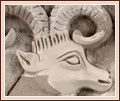 [/kish/fieldmus/images/OB5-large.jpg]
[/kish/fieldmus/images/OB5-large.jpg]
The Kish Expedition excavated seven buildings whose walls were embellished with elaborate stucco decoration. This panel, showing a ram's head above a pair of wings, surmounted an archway in one of those elite residential structures.
Kish East, Mound H, Sasanian Palace 1. Stucco. Sasanian Period, ca. A.D. 400. Field Museum 228841
Net Sinkers
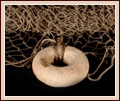 [/kish/fieldmus/images/OB2-large.jpg]
[/kish/fieldmus/images/OB2-large.jpg]
Mesopotamia was a land criss-crossed by irrigation canals and dotted with extensive marshlands. All this water teemed with fish, which were an important source of food, as well as with other wildlife such as water fowl and frogs. Archaeologists have found net-sinkers like those shown here still attached to ancient nets (replaced in this photo by a modern one).
Kish East, Mound A, and Kish, General. Baked clay. Early Dynastic Period. Field Museum 229990,229377,229810,229417
Dagger
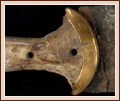 [/kish/fieldmus/images/OB32-large.jpg]
[/kish/fieldmus/images/OB32-large.jpg]
This elaborate dagger, made of exotic and costly materials, was useful only to demonstrate the wealth of the person who owned it. Because the iron was cast long before the technique of forging was developed, it would have been too soft to be used, and the ivory handle would have fragmented upon any type of impact.
Kish. Iron, ivory, gold. Early Dynastic Period. Field Museum 236415
Beads
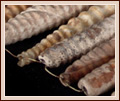 [/kish/fieldmus/images/OB1-large.jpg]
[/kish/fieldmus/images/OB1-large.jpg]
These long, slender beads were made from the cores of large shells that had to be imported from the Persian Gulf or the Indian Ocean. Their presence in this grave attests to the wealth of the individual buried there.
Kish East, Ingharra, Y Sounding, 6 m. below plain level, Burial Y370. Shell. Early Dynastic. Field Museum 236296
Spouted Vessel
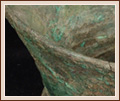 [/kish/fieldmus/images/OB6-large.jpg]
[/kish/fieldmus/images/OB6-large.jpg]
The ancient Mesopotamians used copper alloy to produce weapons, implements, and vessels of various types. This elegant copper pitcher probably came from a burial.
Kish. Copper alloy. Early Dynastic Period. Field Museum 228481
Necklace
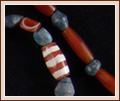 [/kish/fieldmus/images/OB18-large.jpg]
[/kish/fieldmus/images/OB18-large.jpg]
Jewelry made of brightly colored exotic stone attests to the wealth of many of the individuals buried in the Kish cemeteries. Since these materials were not available in southern Mesopotamia, they had to be imported via trade networks that extended over considerable distances. Lapis lazuli, prized for its deep blue color, most likely came from northern Afghanistan while red carnelian came from Iran or, in some instances, from as far as the Indus Valley. Most of the stones were imported in unworked form, but the carnelian beads etched with white were made in the Indus Valley and brought to Mesopotamia from there.
Kish East, Mound A, Burial A51. Lapis lazuli, carnelian, stone. Field Museum 228533
Relief Showing a Lion Attacking a Bull
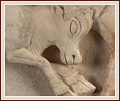 [/kish/fieldmus/images/OB7-large.jpg]
[/kish/fieldmus/images/OB7-large.jpg]
The Asiatic lion, smaller than its African counterpart, ranged throughout what is now Iraq until the early years of the 20th century. Combats between lions and herbivores, both domesticated and wild, were a common theme in Mesopotamian art. They may symbolize the balance of forces (e.g., wild and domestic, predator and prey) which maintains order and prevents chaos.
Kish East, Mound H, Sasanian Palace 1. Stucco. Sasanian Period, ca. A.D. 400. Field Museum 228073
Beads
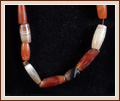 [/kish/fieldmus/images/OB12-large.jpg]
[/kish/fieldmus/images/OB12-large.jpg]
Jewelry made of brightly colored exotic stones attests to the wealth of many of the individuals buried in the Kish cemeteries. Since these materials were not available in southern Mesopotamia, they had to be imported via trade networks that extended over considerable distances. Lapis lazuli, prized for its deep blue color, most likely came from northern Afghanistan while red carnelian came from Iran or, in some instances, from as far as the Indus Valley. Texts show that banded agate, used for some of the beads pictured here, was the material valued above all others by the ancient Mesopotamians.
Kish West, Mound W. Lapis lazuli, carnelian, agate. Field Museum 156815
Fruit Stand
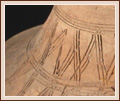 [/kish/fieldmus/images/OB14-large.jpg]
[/kish/fieldmus/images/OB14-large.jpg]
Tall stands are a type of pottery found in many Early Dynastic graves at Kish. Their exact purpose is not known, but one possibility is that they held food to nourish the deceased in the afterlife.
Kish. Baked clay. Early Dynastic Period. Field Museum 157094
Spouted Monochrome Pot
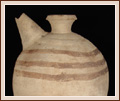 [/kish/fieldmus/images/OB15-large.jpg]
[/kish/fieldmus/images/OB15-large.jpg]
Vessels decorated with shades of red and dark brown are characteristic of the Jamdat Nasr Period, which takes its name from one of the sites excavated by the Kish Expedition. This spouted jar is decorated with simple horizontal bands of plum-red paint.
Jamdat Nasr. Baked clay. Jamdat Nasr Period. Field Museum 158323
Cylinder Seal and Impression
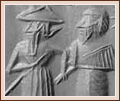 [/kish/fieldmus/images/OB9-large.jpg]
[/kish/fieldmus/images/OB9-large.jpg]
Seals were invented in the Near East approximately 10,000 years ago and are still used in Iraq today. Ancient Mesopotamians used seals to seal doors and containers in which items were traded or stored. An intact sealing indicated that no one had tampered with the contents and identified the agent or agency that had affixed the seal. On this seal [/kish/fieldmus/images/OB11-large.jpg], two deities are leading a worshipper into the presence of a third god, whose lower body has the form of a snake.
Kish East, Ingharra, A-1, 5 m. Stone. Akkadian Period. Field Museum 156668
Solid-Footed Chalice
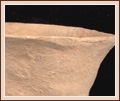 [/kish/fieldmus/images/OB17-large.jpg]
[/kish/fieldmus/images/OB17-large.jpg]
Solid-footed chalices are found in great numbers in levels dating to the first part of the Early Dynastic Period. They are shown held in the hands of statues dedicated in temples and may have been used to pour libations onto altars.
Kish. Baked clay. Early Dynastic Period. Field Museum 2002.1.556
Saw
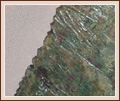 [/kish/fieldmus/images/OB10-large.jpg]
[/kish/fieldmus/images/OB10-large.jpg]
The chariot burials at Kish were rich in metalwork. Objects made of copper alloy included both weapons and implements such as this saw, which was probably originally mounted in a wooden handle.
Kish East, Ingharra, Y Sounding, 6 m. below plain, Chariot Burial 2. Copper alloy. Early Dynastic Period. Field Museum 156600
Flint Sickle Blades
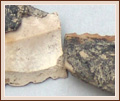 [/kish/fieldmus/images/OB16-large.jpg]
[/kish/fieldmus/images/OB16-large.jpg]
Wooden sickles in which serrated flint blades were hafted in bitumen were used in ancient Mesopotamia to harvest grains, which were the mainstays of life. Barley, emmer-wheat, wheat, and millet were all grown, with barley being utilized more than any of the other grains.
Kish East, Ingharra, Y Sounding, low levels. Flint, bitumen. Early Dynastic Period. Ashmolean Museum 1931.182
Horse on Wheels
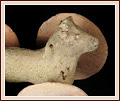 [/kish/fieldmus/images/OB4-large.jpg]
[/kish/fieldmus/images/OB4-large.jpg]
Animal figurines and vessels in the shape of animals were sometimes made into four-wheeled vehicles, the function of which is not known. They are found both in temples and in private houses, where they might have been used as toys.
Kish. Baked clay. Probably Early Dynastic Period. Field Museum 229627-2
Axe/Chisel
 [/kish/fieldmus/images/OB18-large.jpg]
[/kish/fieldmus/images/OB18-large.jpg]
Many of the burials excavated at Kish were rich in metalwork. Objects made of copper alloy included both weapons and implements such as this axe or chisel, which was probably originally mounted in a wooden handle.
Kish East, Ingharra, Y Sounding, 6 m. below plain, Burial Y684. Copper alloy. Early Dynastic Period. Field Museum 236147
Tablet with Pictographic Inscription
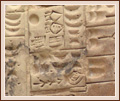 [/kish/fieldmus/images/OB30-large.jpg]
[/kish/fieldmus/images/OB30-large.jpg]
Tablets found at Jamdat Nasr date to an early stage in the development of Mesopotamian cuneiform script and are difficult to translate. This tablet seems to be an accounting, perhaps for the length of one year, of various commodities that were stored or distributed in different types of vessels. In the lower right-hand corner of the tablet is the pictogram for "to eat," which combines a bowl and the profile view of a human head. At the top of the same block of text is the sign thought to represent the name of the ancient city whose ruins are now known as Jamdat Nasr.
Jamdat Nasr. Clay. Jamdat Nasr Period. Ashmolean Museum 1926.564
Vessel
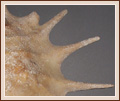 [/kish/fieldmus/images/OB26-large.jpg]
[/kish/fieldmus/images/OB26-large.jpg]
The ancient Mesopotamians imported shells from the Persian Gulf and Indian Ocean to be worked into jewelry or used as containers, such as the one shown here. This shell may have been used as a lamp or as an elaborate drinking vessel.
Kish East, Ingharra, Y Sounding, 6 m. below plain, Burial Y370. Shell. Early Dynastic Period. Field Museum 236636 (interior [/kish/fieldmus/images/OB27-large.jpg] and exterior [/kish/fieldmus/images/OB26-large.jpg])
Vessel
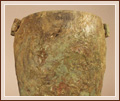 [/kish/fieldmus/images/OB20-large.jpg]
[/kish/fieldmus/images/OB20-large.jpg]
Objects made of copper alloy found at Kish included weapons, implements, and vessels of various types. This tall container has two lugs on each side near the rim that served to attach a metal handle, which no longer survives.
Vessel. Kish. Copper alloy. Early Dynastic Period. Field Museum 236148
Terret (Rein Ring)
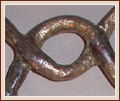 [/kish/fieldmus/images/OB24-large.jpg]
[/kish/fieldmus/images/OB24-large.jpg]
The chariots/carts found in the Y Sounding at Kish were equipped with terets, through which the reins would have passed. Some of these were abstract in form, others were surmounted by animals such as horses or stags.
Kish East, Ingharra, Y Sounding, Chariot Burial 2. Copper alloy. Early Dynastic Period. Field Museum 236525
Goad
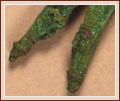 [/kish/fieldmus/images/OB21-large.jpg]
[/kish/fieldmus/images/OB21-large.jpg]
Many of the burials excavated at Kish were rich in metalwork. Objects made of copper alloy included both weapons and implements such as the one shown here. This type of artifact is usually interpreted as a goad, which would have been mounted in a wooden handle and used to prod the animals that pulled the vehicles like those found in the chariot burials at Kish.
Kish East, Ingharra, Y Sounding, 6 m. below plain level, Burial Y631. Copper alloy. Early Dynastic Period. Field Museum 236346
Chariot Wheels
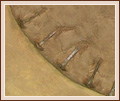 [/kish/fieldmus/images/OB22-large.jpg]
[/kish/fieldmus/images/OB22-large.jpg]
The chariots/carts found in the Y Sounding at Kish are the earliest wheeled vehicles known. The wheels of the chariots had been compressed by the weight of the soil, which makes them appear to be oval. The wood had almost completely disintegrated, but the shape and appearance of the wheels (and the copper nails that studded their rims) were recovered by encasing them in plaster to be shipped to Chicago for conservation and reconstruction. These photographs show how the wheels look today.
Kish East, Ingharra, Y Sounding, Chariot Burial. Copper alloy. Early Dynastic Period. Field Museum 236406 A [/kish/fieldmus/images/OB22-large.jpg] and B [/kish/fieldmus/images/OB23-large.jpg]
Bust of a King
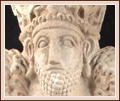 [/kish/fieldmus/images/OB31-large.jpg]
[/kish/fieldmus/images/OB31-large.jpg]
The Kish Expedition excavated seven buildings whose walls were embellished with elaborate stucco decoration. The figure shown here is that of a Sasanian king, identified by his crown as either Shapur II (A.D. 310-379) or Bahram V (A.D. 420-438).
Kish East, Mound II, Sasanian Palace 1. Stucco. Sasanian Period, ca. A.D. 400. Field Museum 236400a
Terets (Rein Rings)
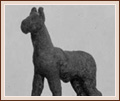 [/kish/fieldmus/images/OB25-large.jpg]
[/kish/fieldmus/images/OB25-large.jpg]
The chariots/carts found in the Y Sounding at Kish were equipped with terets, through which the reins would have passed. Some of these were abstract in form, others were surmounted by animals such as the horse and stag shown here.
Kish East, Ingharra, Y Sounding, Chariot Burials 3 and 2. Copper alloy. Early Dynastic Period. Field Museum 236527 (horse), 236528 (stag)
Needle
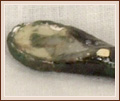 [/kish/fieldmus/images/OOB8-large.jpg]
[/kish/fieldmus/images/OOB8-large.jpg]
Ancient Mesopotamian needles resemble modern ones in being long and slender, with a slit-shaped eye.
Kish East, Mound A, 1 m., on outside of west wall. Copper alloy. Field Museum 158015
Inlaid Panel
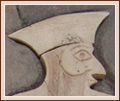 [/kish/fieldmus/images/OB29-large.jpg]
[/kish/fieldmus/images/OB29-large.jpg]
Inlaid panels decorated two of the rooms in the palace on Mound A. One panel shows a triumphal military procession with soldiers leading in captives and animals (rams, bulls, and goats) as booty. This decoration glorified the military exploits of the ruler who inhabited the palace and proclaimed his might to all visitors.
Kish East, Mound A, Palace. Slate, sandstone, mother-of-pearl, shell. Early Dynastic Period. Ashmolean Museum 1924.702
Stylus
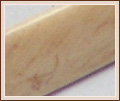 [/kish/fieldmus/images/OB33-large.jpg]
[/kish/fieldmus/images/OB33-large.jpg]
This polished bone implement is triangular in section and tapered at one end. It most likely was used as a stylus to impress cuneiform signs on clay tablets.
Kish West, Uhaimir, House Ruins, About 1 meter below surface. Bone. Assyrian Period or Later. Ashmolean Museum 1924.53
The Field Museum
The Field Museum, 'Object Gallery', The Field Museum's Kish Database Project, 2004-09, The Field Museum, 2025 [http://oracc.org/kish/fieldmus/ObjectGallery/]